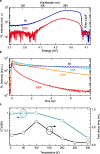Deep-UV nitride-on-silicon microdisk lasers
- PMID: 26887701
- PMCID: PMC4757875
- DOI: 10.1038/srep21650
Deep-UV nitride-on-silicon microdisk lasers
Abstract
Deep ultra-violet semiconductor lasers have numerous applications for optical storage and biochemistry. Many strategies based on nitride heterostructures and adapted substrates have been investigated to develop efficient active layers in this spectral range, starting with AlGaN quantum wells on AlN substrates and more recently sapphire and SiC substrates. Here we report an efficient and simple solution relying on binary GaN/AlN quantum wells grown on a thin AlN buffer layer on a silicon substrate. This active region is embedded in microdisk photonic resonators of high quality factors and allows the demonstration of a deep ultra-violet microlaser operating at 275 nm at room temperature under optical pumping, with a spontaneous emission coupling factor β = (4 ± 2) 10(-4). The ability of the active layer to be released from the silicon substrate and to be grown on silicon-on-insulator substrates opens the way to future developments of nitride nanophotonic platforms on silicon.
Figures




References
-
- Nanishi Y. Nobel Prize in Physics: The birth of the blue LED. Nat. Photonics 10.1038/nphoton.2014.291 (2014) - DOI
-
- Amano H., Kito M., Hiramatsu K. & Akasaki I. P-Type Conduction in Mg-Doped GaN Treated with Low-Energy Electron Beam Irradiation (LEEBI). Jpn. J. Appl. Phys. 28, L2112–L2114 (1989).
-
- Nakamura S., Mukai T. & Senoh M. High-Power GaN P-N Junction Blue-Light-Emitting Diodes. Jpn. J. Appl. Phys. 30, L1998–L2001 (1991).
-
- Pust P. et al. Narrow-band red-emitting Sr[LiAl3N4]:Eu2+ as a next-generation LED-phosphor material. Nat. Mater 13, 891–896 (2014). - PubMed
-
- Taniyasu Y., Kasu M. & Makimoto T. An aluminium nitride light-emitting diode with a wavelength of 210 nanometres. Nature 441, 325–328 (2006). - PubMed
Publication types
LinkOut - more resources
Full Text Sources
Other Literature Sources

